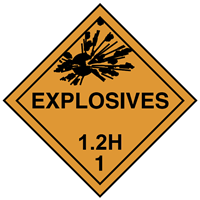
 Print
Print
Chemical Datasheet
AMMUNITION, INCENDIARY, WHITE PHOSPHORUS WITH BURSTER, EXPELLING CHARGE OR PROPELLING CHARGE |

|
Chemical Identifiers
| CAS Number |
UN/NA Number |
DOT Hazard Label |
USCG CHRIS Code |
|
none
|
|
|
none
|
| NIOSH Pocket Guide |
International Chem Safety Card |
|
none
|
none
|
NFPA 704
data unavailable
General Description
Fixed ammunition consisting of a cartridge case containing a propelling charge, a primer and a projectile containing white phosphorus and a burster. Shipped fuzed or unfuzed. May explode under prolonged exposure to heat or fire. Primary hazard is flying projectiles or fragments, not blast of an instantaneous explosion.
Hazards
Reactivity Alerts
- Explosive
- Strong Reducing Agent
- Air-Reactive
Air & Water Reactions
When exposed to air emits a green light and gives off white fumes. Ignites at 30°C in moist air, higher temperatures are required for ignition in dry air [Merck 11th ed. 1989]. The reactivity of phosphorus with oxygen or air depends on the allotrope of phosphorus involved and the conditions of contact, white (yellow) phosphorus being by far more reactive. White phosphorus readily ignites in air if warmed, finely divided, or under conditions where the slow oxidative isotherm cannot be dissipated. Contact with finely divided charcoal or lampblack promotes ignition, probably by the absorbed oxygen. Contact with amalgamated aluminum also promotes ignition [Mellor 1940 and 1971].
Fire Hazard
Excerpt from ERG Guide 112 [Explosives - Division 1.1, 1.2, 1.3 or 1.5]:
MAY EXPLODE AND THROW FRAGMENTS 1600 METERS (1 MILE) OR MORE IF FIRE REACHES CARGO. (ERG, 2024)
Health Hazard
Excerpt from ERG Guide 112 [Explosives - Division 1.1, 1.2, 1.3 or 1.5]:
Fire may produce irritating, corrosive and/or toxic gases. (ERG, 2024)
Reactivity Profile
AMMUNITION, INCENDIARY, WHITE PHOSPHORUS WITH BURSTER, EXPELLING CHARGE OR PROPELLING CHARGE contains various quantities of phosphorus. Bromine trifluoride reacts with phosphorus incandescently at ambient temperatures [Mellor 2:113. 1946-47]. Bromoazide explodes on contact with antimony, arsenic, phosphorus, silver foil, or sodium. Red phosphorus reacts in the cold with selenium oxychloride evolving light and heat; white phosphorus reacts explosively [Mellor 10:906. 1946-47]. When thorium is heated with phosphorus, they unite with incandescence [Svenska Akad. 1829. p. 1].
Belongs to the Following Reactive Group(s)
Potentially Incompatible Absorbents
No information available.
Response Recommendations
Isolation and Evacuation
Excerpt from ERG Guide 112 [Explosives - Division 1.1, 1.2, 1.3 or 1.5]:
IMMEDIATE PRECAUTIONARY MEASURE: Isolate spill or leak area immediately for at least 500 meters (1/3 mile) in all directions.
LARGE SPILL: Consider initial evacuation for 800 meters (1/2 mile) in all directions.
FIRE: If rail car or trailer is involved in a fire, ISOLATE for 1600 meters (1 mile) in all directions; also, initiate evacuation including emergency responders for 1600 meters (1 mile) in all directions. (ERG, 2024)
Firefighting
Excerpt from ERG Guide 112 [Explosives - Division 1.1, 1.2, 1.3 or 1.5]:
CARGO FIRE: DO NOT fight fire when fire reaches cargo! Cargo may EXPLODE! Stop all traffic and clear the area for at least 1600 meters (1 mile) in all directions and let burn. Do not move cargo or vehicle if cargo has been exposed to heat.
TIRE OR VEHICLE FIRE: Use plenty of water - FLOOD it! If water is not available, use CO2, dry chemical or dirt. If possible, and WITHOUT RISK, use unmanned master stream devices or monitor nozzles from maximum distance to prevent fire from spreading to cargo area. Pay special attention to tire fires as re-ignition may occur. Stand by, at a safe distance, with extinguisher ready for possible re-ignition. (ERG, 2024)
Non-Fire Response
Excerpt from ERG Guide 112 [Explosives - Division 1.1, 1.2, 1.3 or 1.5]:
ELIMINATE all ignition sources (no smoking, flares, sparks or flames) from immediate area. All equipment used when handling the product must be grounded. Do not touch or walk through spilled material. DO NOT OPERATE RADIO TRANSMITTERS WITHIN 100 METERS (330 FEET) OF ELECTRIC DETONATORS. DO NOT CLEAN-UP OR DISPOSE OF, EXCEPT UNDER SUPERVISION OF A SPECIALIST. (ERG, 2024)
Protective Clothing
Excerpt from ERG Guide 112 [Explosives - Division 1.1, 1.2, 1.3 or 1.5]:
Wear positive pressure self-contained breathing apparatus (SCBA). Structural firefighters' protective clothing provides thermal protection but only limited chemical protection. (ERG, 2024)
DuPont Tychem® Suit Fabrics
No information available.
First Aid
Excerpt from ERG Guide 112 [Explosives - Division 1.1, 1.2, 1.3 or 1.5]:
Refer to the "General First Aid" section. (ERG, 2024)
Physical Properties
Chemical Formula:
data unavailable
Flash Point: data unavailable
Lower Explosive Limit (LEL): data unavailable
Upper Explosive Limit (UEL): data unavailable
Autoignition Temperature: data unavailable
Melting Point: data unavailable
Vapor Pressure: data unavailable
Vapor Density (Relative to Air): data unavailable
Specific Gravity: data unavailable
Boiling Point: data unavailable
Molecular Weight: data unavailable
Water Solubility: data unavailable
Ionization Energy/Potential: data unavailable
IDLH: data unavailable
AEGLs (Acute Exposure Guideline Levels)
No AEGL information available.
ERPGs (Emergency Response Planning Guidelines)
No ERPG information available.
PACs (Protective Action Criteria)
No PAC information available.
Regulatory Information
EPA Consolidated List of Lists
No regulatory information available.
CISA Chemical Facility Anti-Terrorism Standards (CFATS)
No regulatory information available.
OSHA Process Safety Management (PSM) Standard List
No regulatory information available.
Alternate Chemical Names
- AMMUNITION, INCENDIARY, WHITE PHOSPHORUS WITH BURSTER, EXPELLING CHARGE OR PROPELLING CHARGE


 Print
Print
